Unit: AM/FM Stereo Receiver
Manufacturer: Marantz
Model: 2275
SN: P080125
Today I'm showcasing a Marantz 2275 vintage receiver that came in for restoration. This model is the successor to the famous Marantz 2270 manufactured from 1972 to 1974. The Marantz 2275 is another step forward and is considered one of the best Marantz receivers ever. This model was manufactured from 1975 to 1977. It delivers 75 watts per channel into 8 ohms with no more than 0.25% total harmonic distortion. The optional walnut veneer cabinet for this model is WC-22.
This particular unit is a European version equipped with a universal power transformer. According to the factory stamp on the chassis, this receiver was manufactured in October 1976.
Power Supply & Protection Relay Circuit (P800)
The power supply & protection relay circuit board has 8 aluminum electrolytic capacitors: C801, C802, C804, C805, C806, C807, C808, and C809.
I replaced all capacitors on this board with low impedance Nichicon UPW/UPM caps.
The original e-caps were tested with an Atlas ESR70 capacitance meter; the results are below.
Test results on original capacitors removed from the power supply & protection relay circuit board:
C801: rated capacitance – 220uF, measured – 244uF, ESR – 0.15Ω, deviation: +11%
C802: rated capacitance – 100uF, measured – 126uF, ESR – 0.12Ω, deviation: +26%
C804: rated capacitance – 22uF, measured – 25uF, ESR – 0.28Ω, deviation: +14%
C805: rated capacitance – 330uF, measured – 346uF, ESR – 0.11Ω, deviation: +5%
C806: rated capacitance – 470uF, measured – 467uF, ESR – 0.31Ω, deviation: -1%
C807: rated capacitance – 10uF, measured – 12uF, ESR – 0.43Ω, deviation: +20%
C808: rated capacitance – 47uF, measured – 54uF, ESR – 0.62Ω, deviation: +15%
C809: rated capacitance – 220uF, measured – 280uF, ESR – 0.16Ω, deviation: +27%
I also replaced all transistors on this board to improve the reliability of the power supply. Below is a list of original and replacement transistors that I have used. A fresh silicone thermal compound (Wakefield-Vette, 120 series) was applied between the new MJE15030G transistor installed in position H804 and the heat sink.
Q801: NPN, 2SD330 (original), replaced with a new Fairchild MJE15030G
Q802: NPN, 2SC1318 (original), replaced with a new Fairchild KSC2690AYSTU
Q803: NPN, 2SC945 (original), replaced with a new Fairchild KSC2383YTA
Q804: NPN, 2SD331 (original), replaced with a new Fairchild MJE15030G
Q805: NPN, 2SC945 (original), replaced with a new Fairchild KSC945CYTA
Q806: NPN, 2SC1318 (original), replaced with a new Fairchild KSC2383YTA
Q807: NPN, 2SC1318 (original), replaced with a new Fairchild KSC2383YTA
The original trimming resistor R806 on this board was also replaced with a new Bourns potentiometer.
Finally, the original protection relay was replaced with a new Omron relay to improve overall reliability.
After the servicing, the voltage between pin J804 and J805 (ground) was adjusted to +35.0V DC with trimming resistor R806.
Power supply & protection relay circuit board - voltage regulator adjustment
Power supply & protection relay circuit board - before and after
Power Amplifier Board (P700)
There are two power amplifier boards in Marantz 2275. Each board is mounted directly on the heatsink with two power transistors. The entire assembly can be easily removed from the chassis for servicing. This thoughtful engineering design makes life easier for technicians.
Power amplifier board - removed from the chassis
Each board has one low leakage e-cap C702 and 2 ordinary aluminum electrolytic capacitors (C703 and C704).
The original low leakage e-cap was replaced with modern low leakage Nichicon UKL cap. And, the remaining aluminum e-caps were replaced with low impedance Nichicon UPW caps.
Test results on original capacitors removed from the power amplifier board:
Left channel
C702: rated capacitance – 47uF, measured – 45uF, ESR – 0.36Ω, deviation: -4%
C703: rated capacitance – 10uF, measured – 13uF, ESR – 2.6Ω, deviation: +30%
C704: rated capacitance – 10uF, measured – 12uF, ESR – 1.51Ω, deviation: +20%
Right channel
C702: rated capacitance – 47uF, measured – 47uF, ESR – 0.51Ω, deviation: 0%
C703: rated capacitance – 10uF, measured – 13uF, ESR – 161Ω, deviation: +30%
C704: rated capacitance – 10uF, measured – 13uF, ESR – 3.1Ω, deviation: +30%
The first stage of the power amplifier circuit is a differential amplifier consisting of two amplifying transistors with a common emitter: H701 and H702. The original NPN transistor installed in these positions is 2SC1327. This transistor is not on my list of infamous transistors that are prone to failure. But, I decided to unsolder the original transistors and test them to make sure that they are still well matched by current gain.
Testing showed that both pairs of 2SC1327s are matched within ~3% in terms of current gain. This is a very good result for almost 50 years old electronic components. However, I decided to replace each pair of original 2SC1327 transistors with a new close-matched pair of modern low-noise Fairchild KSC1845s. Two transistors installed in a differential amplifier are supposed to be precisely matched to work properly in the circuit. So, it always makes sense to replace the old electronic components installed in the critical positions with new high quality parts. Each pair of new KSC1845 transistors was carefully matched (within ~1%) by current gain and base-emitter voltage.
I put a slight smear of new thermal paste on one face of KSC1845 and pressed both transistors together. A piece of heat shrink tubing was used to hold them together mechanically as in the original transistors.
Test results on original 2SC1327 transistors
H701 (left channel): hfe - 557, Vbe - 0.757V
H702 (left channel): hfe - 572, Vbe - 0.757V
H701 (right channel): hfe - 676, Vbe - 0.758V
H702 (right channel): hfe - 692, Vbe - 0.759V
Test results on new KSC1845 transistors
H701 (left channel): hfe - 443, Vbe - 0.749V
H702 (left channel): hfe - 440, Vbe - 0.749V
H701 (right channel): hfe - 439, Vbe - 0.750V
H702 (right channel): hfe - 437, Vbe - 0.749V
The original 2SA721 pre-driver transistor installed in position H703 is on my list of transistors that are prone to failure. I replaced it with a new low-noise Fairchild KSA992 transistor. The original 2SC1327 transistor installed in position H704 was also replaced with modern low-noise Fairchild KSC1845 since it is complemented to 2SA721.
Power amplifier board - before and after (only one board is shown)
Phono Amplifier Board (P400)
The phono amplifier board has 2 solid tantalum capacitors (C401, C402) installed in the input signal path, 2 low leakage e-caps (C403, C404), and an aluminum filtering e-cap C413.
The original tantalum capacitors were replaced with high-quality film polyester WIMA caps. The original low leakage e-caps were replaced with modern low leakage Nichicon UKL caps. The design of the printed circuit board allows the installation of an axial or radial capacitor in position C413. I replaced the original axial e-cap C413 with a radial type low impedance Nichicon UPW cap.
Test results on original capacitors removed from the phono amplifier board:
C401: rated capacitance – 1uF, measured – 1uF, ESR – 11.8Ω, deviation: 0%
C402: rated capacitance – 1uF, measured – 1uF, ESR – 3.2Ω, deviation: 0%
C403: rated capacitance – 47uF, measured – 61uF, ESR – 0.48Ω, deviation: +30%
C404: rated capacitance – 47uF, measured – 60uF, ESR – 0.46Ω, deviation: +28%
C413: rated capacitance – 100uF, measured – 119uF, ESR – 1.46Ω, deviation: +19%
The original 2SC1344 Hitachi NPN transistor installed in positions H401 to H404 is on my list of transistors that are prone to failure. I replaced all 2SC1344s with low-noise Fairchild KSC1845 transistors. Watch the pinout on replacement transistors. The original transistor is BCE and the new one is ECB. Also, make sure that the new transistors installed in the first stage of the phono stage have a high current gain of 400 or more.
The original 2SC1775 Hitachi NPN transistor installed in positions H405 and H406 was also replaced with low-noise Fairchild KSC1845 transistor. The replacement transistor has the same pinout as the original one.
The failure-prone VD1212 dual diode installed in position H409 was replaced with a pair of 1N4148 diodes in series.
Phono amplifier board - before and after
Power Transistors
All original power transistors were removed, degreased, and tested with Atlas DCA55 semiconductor analyzer. The test showed that the NPN transistor H004 has a shunt between the base and the emitter. The measured resistance between the base and emitter was very low at ~16.1kΩ. The remaining three transistors passed the test.
I did not find a datasheet for the original power transistors installed in this unit. However, both transistors (S40443 and S40442) from the left channel have a relatively low current gain of ~28. Because of all these problems, I decided to replace the original power transistors in each channel with new ON Semiconductor MJ21194G / MJ21193G transistors. The new transistors are specifically designed for high-power audio output, have excellent gain linearity, and complement each other. The new Mica pads and fresh thermal compound were applied between each power transistor and heat sink.
Test results on original power transistors:
H001, S40442, PNP, hfe = 29, Vbe = 0.564V
H002, S40443, NPN, hfe = 28, Vbe = 0.597V
H003, S40442, PNP, hfe = 76, Vbe = 0.581V
H004, S40443, NPN, shunt between the base and the emitter
Test results on new ON Semiconductor power transistors:
H001, MJ21193G, PNP, hfe = 74, Vbe = 0.592V
H002, MJ21194G, NPN, hfe = 54, Vbe = 0.596V
H003, MJ21193G, PNP, hfe = 86, Vbe = 0.615V
H004, MJ21194G, NPN, hfe = 53, Vbe = 0.603V
NPN power transistor S40443 from the right channel - shunt between the base and emitter
New ON Semiconductor power transistors - left and right channels
Pre & Tone Amplifier Board (PE01)
The pre & tone amplifier board must be removed from the chassis for servicing. I recommend removing the phono amplifier board and one bracket underneath it before attempting to free the pre & tone amplifier board. In addition, the metal shield under the pre & tone amplifier board needs to be removed to properly clean all the switches underneath.
The pre & tone amplifier board (PE01) is removed from the chassis
The pre & tone amplifier board has 6 solid tantalum capacitors (CE13, CE14, CE33, CE34, CE35, CE36) installed in the signal path, 2 bi-polar e-caps (CE37, CE38) installed in the output signal path, and 5 aluminum electrolytic capacitors (CE09, CE10, CE11, CE12, CE39).
Two original tantalum capacitors (CE33, CE34) with a rated capacitance of 1uF were replaced with film polyester WIMA caps. The other 4 tantalum e-caps were replaced with modern low leakage Nichicon UKL caps. Two bi-polar e-caps were replaced with new bi-polar Nichicon UES caps. And the remaining aluminum e-caps were replaced with low impedance Nichicon UPW caps.
Test results on original capacitors removed from the pre & tone amplifier board:
CE09: rated capacitance – 100uF, measured – 117uF, ESR – 0.46Ω, deviation: +17%
CE10: rated capacitance – 100uF, measured – 131uF, ESR – 0.32Ω, deviation: +31%
CE11: rated capacitance – 10uF, measured – 13uF, ESR – 0.44Ω, deviation: +30%
CE12: rated capacitance – 10uF, measured – 12uF, ESR – 0.61Ω, deviation: +20%
CE13: rated capacitance – 3.3uF, measured – 3.3uF, ESR – 1.68Ω, deviation: 0%
CE14: rated capacitance – 3.3uF, measured – 3.2uF, ESR – 2.6Ω, deviation: -3%
CE33: rated capacitance – 1uF, measured – 1uF, ESR – 4.4Ω, deviation: 0%
CE34: rated capacitance – 1uF, measured – 1uF, ESR – 4.8Ω, deviation: 0%
CE35: rated capacitance – 3.3uF, measured – 3.3uF, ESR – 2.0Ω, deviation: 0%
CE36: rated capacitance – 3.3uF, measured – 3.4uF, ESR – 2.3Ω, deviation: +3%
CE37: rated capacitance – 4.7uF, measured – 4.6uF, ESR – 1.55Ω, deviation: -2%
CE38: rated capacitance – 4.7uF, measured – 4.3uF, ESR – 2.1Ω, deviation: -9%
CE39: rated capacitance – 220uF, measured – 187uF, ESR – 0.09Ω, deviation: -15%
The failure-prone 2SA721 transistor installed in positions HE04 and HE06 was replaced with low-noise Fairchild KSA992 transistor. Also, the original 2SC1327 transistor installed in positions HE03 and HE05 was also replaced with low-noise Fairchild KSC1845 since it is complemented to 2SA721.
Pre and tone amplifier board - before and after
AM Tuner Board (P150)
The AM tuner board has one low leakage e-cap (C171) and 6 aluminum electrolytic capacitors (C167, C168, C169, C170, C172, C173).
The original low leakage e-cap was replaced with a film polyester WIMA cap. The remaining aluminum e-caps were replaced with low impedance Nichicon UPW caps.
Test results on original capacitors removed from the AM tuner board:
C167: rated capacitance – 22uF, measured – 29uF, ESR – 0.51Ω, deviation: +32%
C168: rated capacitance – 100uF, measured – 121uF, ESR – 0.18Ω, deviation: +21%
C169: rated capacitance – 4.7uF, measured – 5.5uF, ESR – 1.46Ω, deviation: +17%
C170: rated capacitance – 100uF, measured – 124uF, ESR – 0.34Ω, deviation: +24%
C171: rated capacitance – 1uF, measured – 1uF, ESR – 2.3Ω, deviation: 0%
C172: rated capacitance – 100uF, measured – 123uF, ESR – 0.12Ω, deviation: +23%
C173: rated capacitance – 4.7uF, measured – 5.5uF, ESR – 1.34Ω, deviation: +17%
AM tuner board - before and after
Dolby FM Level Amplifier Board (PC01)
This board has only 4 solid tantalum capacitors: CC01, CC02, CC03, and CC04. I replaced them with film polyester WIMA caps.
Test results on original capacitors removed from the Dolby FM level amplifier board:
CC01: rated capacitance – 1uF, measured – 1uF, ESR – 4.3Ω, deviation: 0%
CC02: rated capacitance – 1uF, measured – 1uF, ESR – 5.9Ω, deviation: 0%
CC03: rated capacitance – 1uF, measured – 1uF, ESR – 5.0Ω, deviation: 0%
CC04: rated capacitance – 1uF, measured – 1uF, ESR – 5.4Ω, deviation: 0%
Dolby FM level amplifier board - before and after
MPX Stereo Decoding Amplifier Board (P300)
Well, this is the most challenging board for servicing in the Marantz 2275. This board cannot be completely released from the chassis without removing some wires from it. And I don't like the idea to cut any of the original wires unless absolutely necessary. So, I was able to rotate this board about 90 degrees (even less actually) to get to the back (foil) side for servicing after loosening some wires. But the many wires under this board and the very limited space make servicing this board a real challenge. So keep that in mind if you ever decide to service this board in Marantz 2275.
The MPX stereo decoding amplifier board has 3 bipolar electrolytic capacitors (C307, C308, C309), 4 solid tantalum e-caps (C323, C324, C325, C326), and 11 aluminum electrolytic capacitors (C302, C304, C306, C327, C328, C329, C331, C332, C337, C338, C342).
The original bipolar and solid tantalum capacitors were replaced with film polyester WIMA and Kemet caps. Two ordinary aluminum e-caps with a rated capacitance of 1uF (C331, C338) were also replaced with film polyester WIMA caps. The remaining aluminum e-caps were replaced with low impedance Nichicon UPW/UPM caps.
Test results on original capacitors removed from the MPX stereo decoding amplifier board:
C302: rated capacitance – 33uF, measured – 46uF, ESR – 1.1Ω, deviation: +39%
C304: rated capacitance – 22uF, measured – 29uF, ESR – 0.66Ω, deviation: +32%
C306: rated capacitance – 22uF, measured – 29uF, ESR – 0.61Ω, deviation: +32%
C307: rated capacitance – 0.47uF, measured – 0.42uF, ESR – N/A, deviation: -11%
C308: rated capacitance – 0.22uF, measured – 0.31uF, ESR – N/A deviation: +41%
C309: rated capacitance – 0.22uF, measured – 0.28uF, ESR – N/A, deviation: +27%
C323: rated capacitance – 0.22uF, measured – 0.21uF, ESR – N/A, deviation: -5%
C324: rated capacitance – 0.22uF, measured – 0.22uF, ESR – N/A, deviation: 0%
C325: rated capacitance – 1uF, measured – 1uF, ESR – 7.3Ω, deviation: 0%
C326: rated capacitance – 1uF, measured – 1.1uF, ESR – 6.6Ω, deviation: +10%
C327: rated capacitance – 220uF, measured – 191uF, ESR – 0.11Ω, deviation: -13%
C328: rated capacitance – 220uF, measured – 230uF, ESR – 0.14Ω, deviation: +5%
C329: rated capacitance – 10uF, measured – 13uF, ESR – 1.49Ω, deviation: +30%
C331: rated capacitance – 1uF, measured – 1.1uF, ESR – 1.26Ω, deviation: +10%
C332: rated capacitance – 10uF, measured – 13uF, ESR – 1.74Ω, deviation: +30%
C337: rated capacitance – 4.7uF, measured – 5.2uF, ESR – 1.24Ω, deviation: +11%
C338: rated capacitance – 1uF, measured – 1.1uF, ESR – 1.52Ω, deviation: +10%
C342: rated capacitance – 10uF, measured – 13uF, ESR – 1.56Ω, deviation: +30%
FM IF Amplifier Board (P200)
The FM IF amplifier board has one solid tantalum capacitor C256 and 14 aluminum electrolytic capacitors (C204, C205, C208, C218, C219, C229, C242, C243, C244, C245, C248, C249, C250, C261).
Both the original tantalum capacitor C256 and ordinary aluminum e-cap C261 were replaced with a film polyester WIMA cap. The remaining e-caps were replaced with low impedance Nichicon UPW caps.
Test results on original capacitors removed from the FM IF amplifier board:
C204: rated capacitance – 10uF, measured – 14uF, ESR – 1.21Ω, deviation: +40%
C205: rated capacitance – 10uF, measured – 13uF, ESR – 1.24Ω, deviation: +30%
C208: rated capacitance – 10uF, measured – 14uF, ESR – 1.16Ω, deviation: +40%
C218: rated capacitance – 10uF, measured – 13uF, ESR – 1.31Ω, deviation: +30%
C219: rated capacitance – 10uF, measured – 12uF, ESR – 1.02Ω, deviation: +20%
C229: rated capacitance – 10uF, measured – 14uF, ESR – 1.06Ω, deviation: +40%
C242: rated capacitance – 10uF, measured – 13uF, ESR – 1.15Ω, deviation: +30%
C243: rated capacitance – 100uF, measured – 133uF, ESR – 0.31Ω, deviation: +33%
C244: rated capacitance – 10uF, measured – 13uF, ESR – 1.05Ω, deviation: +30%
C245: rated capacitance – 10uF, measured – 13uF, ESR – 1.13Ω, deviation: +30%
C248: rated capacitance – 10uF, measured – 13uF, ESR – 1.04Ω, deviation: +30%
C249: rated capacitance – 100uF, measured – 129uF, ESR – 0.21Ω, deviation: +29%
C250: rated capacitance – 22uF, measured – 29uF, ESR – 0.48Ω, deviation: +32%
C256: rated capacitance – 1uF, measured – 1.1uF, ESR – 4.1Ω, deviation: +10%
C261: rated capacitance – 1uF, measured – 1.2uF, ESR – 1.31Ω, deviation: +20%
FM IF amplifier board - before and after
Dial, Meter, and Functional Lamps
Well, look at the picture below. Do you see something wrong? Yes, the plastic reflector behind the dial lamps has melted. That is why I always recommend replacing the original incandescent lamps in any vintage Marantz with warm white LED lamps. Incandescent lamps produce a lot of heat and eventually destroy the plastic reflector behind them. LED lamps produce much less heat, safe for plastic, and last almost forever. In addition, the color temperature of warm white LED lamps is very close to that of incandescent bulbs. All this makes LED lamps the best replacement for original incandescent bulbs in vintage receivers.
The plastic reflector behind the dial lamps - melted over time
I replaced the old incandescent bulbs with warm white LED lamps to maintain the original look and decrease heat. The original incandescent lamp behind the meter was also replaced with a warm white LED lamp. The old yellowish vellum behind the dial scale was replaced with new heavyweight vellum paper.
Two original functional lamps (FM and Stereo) in this unit burned out. I replaced them with new bi-pin lamps (8V/40mA).
The original dial pointer lamp was also burned out. I replaced it with a new incandescent lamp (8V/60mA, 4.7mm).
Dial scale removed - original incandescent dial lamps
Dial scale removed - new LED lamps
New heavyweight vellum paper
Miscellaneous Issues
- The electrolytic capacitor C008 (33uF/10V) across meter leads was replaced with a new low impedance Nichicon UPW cap.
- The old dial string in this unit was loosened. I replaced it with a new dial cord (the most tedious job on any vintage receiver).
The e-cap C008 across meter leads - original and new
New dial cord
DC offset and Bias Adjustments
The DC offset is measured across speaker terminals on each channel. It should be adjusted as close to zero volts as possible with the trimming resistor R741.
Be aware, that the service manual has an error for bias adjustment. The correct procedure is described below.
The bias on each channel is measured across dual resistor R740. So, the DC voltmeter should be connected between pins J704 (+) and J703 (-). Then, the voltage should be adjusted to ~10mV on each channel with the trimming resistor R742. It corresponds to the idling current of 25mA.
DC offset on the left and right channels after restoration
Bias on the left and right channels after restoration
Output Power Test
The final output power test was performed at the end of my restoration. The receiver was loaded with a low inductance 8Ω/100W dummy resistor for each channel. The oscilloscope was connected across the speaker terminals and a sine-wave signal of 1kHz was applied to the AUX jacks. The output sine-wave signal was perfectly symmetrical on both channels with no clipping up to 27.10 VRMS (left channel) and 27.03 VRMS (right channel). It corresponds to the output power of 91.8W on the left channel and 91.3W on the right channel.
Output power test
As usual, all the knobs and the face plate were gently cleaned in warm water with dish soap. All controls have been cleaned with DeoxIT 5% contact cleaner and lubricated with DeoxIT FaderLube 5% spray.
The final result can be seen in the photos below. The receiver looks awesome, and the sound is clear and warm. Classic Marantz sound from the late 70's! Please watch a short demo video at the end of this post. Thank you for reading.
Marantz 2275 - after restoration
Demo video after repair & restoration

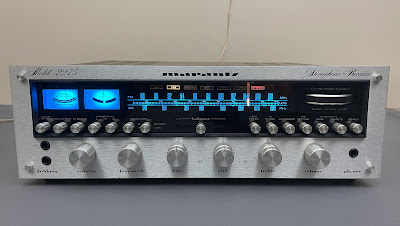
_voltage%20regulator%20adjustment.jpg)
_before%20servicing.jpg)
_after%20servicing.jpg)
_removed%20from%20the%20chassis.jpg)
_before%20servicing.jpg)
_after%20servicing.jpg)
_before%20servicing.jpg)
_after%20servicing.jpg)


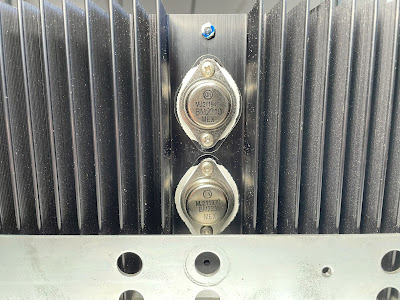
%20removed%20from%20the%20chassis.jpg)
_before%20servicing.jpg)
_after%20servicing.jpg)
_before%20servicing.jpg)
_after%20servicing.jpg)
_before%20servicing.jpg)
_after%20servicing.jpg)
_before%20servicing.jpg)
_after%20servicing.jpg)
_before%20servicing.jpg)
_after%20servicing.jpg)
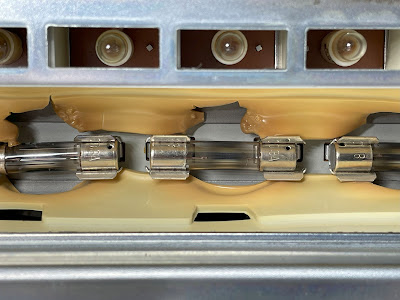

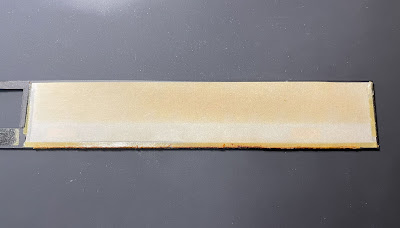
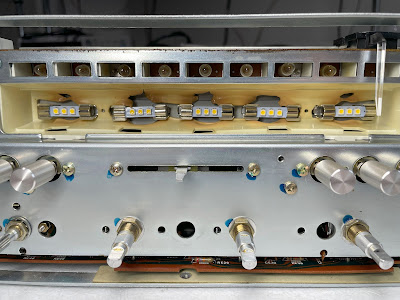






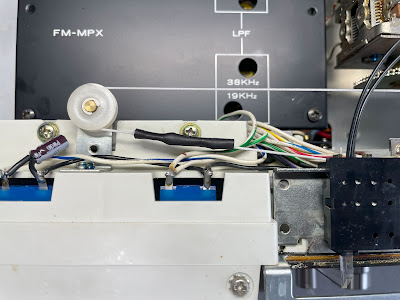

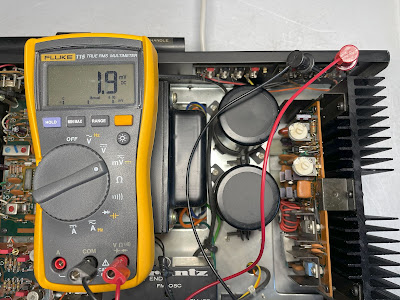
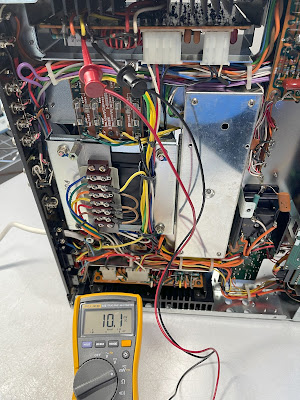

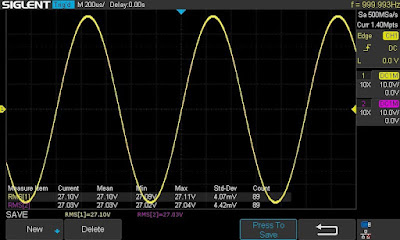


Oleg, i have a stack of receivers sitting here waiting to be restored SX-727, SX-828, SX-838, SX-950 and 2238. I was dreading working on them, but this is so incredibly detailed! This is the best vintage restoration resource i have found to date! Огромное вам спасибо! Я подписываюсь. Это просто сказка! Вы кассетниками и бабинными не занимаетесь? Я то я в Akai GX-636D совсем заблудился.
ReplyDeleteHello Igor! Thank you very much for your kind words about my work. I'm in love with these vintage gears from the 70s. I mostly only repair and restore vintage receivers and amplifiers and have limited experience with cassette decks or reel-to-reels.
DeleteVery nice …just bought one. Loading up on parts-just in case. I’ll download your thread. I’m old and grew up with these.
ReplyDelete